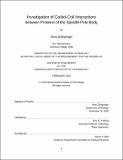Investigation of coiled-coil interactions between proteins of the spindle pole body
Author(s)
Zizlsperger, Nora (Nora A. E.)
DownloadFull printable version (2.421Mb)
Other Contributors
Massachusetts Institute of Technology. Dept. of Biology.
Advisor
Amy E. Keating.
Terms of use
Metadata
Show full item recordAbstract
The spindle pole body (SPB) is a large multi-protein complex that organizes microtubules in yeast. Through its function of nucleating and anchoring microtubules, the SPB is essential for cell viability. High-resolution structures of the SPB have not been achieved using x-ray crystallography, due to its low copy number, large size, heterogeneous composition, and association with the nuclear membrane. However, structural information may be deciphered through a variety of other techniques. Cryo-electron microscopy images have provided a low-resolution model of the SPB. Experiments testing which proteins interact provide additional structural data, although in most cases, it is not known precisely how these interactions occur. Interestingly, a large proportion of SPB proteins are predicted to contain one or more coiled coils. The coiled coil is a common protein-protein interaction domain, consisting of two or more supercoiled [alpha]-helices. The high frequency of coiled coils predicted in SPB proteins suggests that this structure may be important for establishing the overall architecture of the complex. This thesis describes work towards determining whether coiled coils form interactions within or between SPB proteins. All coiled-coil regions predicted in SPB proteins were produced and tested for interactions as individual peptides, taking advantage of the often-observed ability of coiled coils to fold and interact cooperatively, isolated from the rest of the protein. Many self-associating coiled coils and several hetero-associating coiled coils were identified, and structural features of several complexes were determined. (cont.) The results suggest that several SPB coiled coils form supports between layers of the SPB and other coiled coils mediate homo- and hetero-associations within layers or sub-complexes. The coiled-coil interaction data were incorporated with other structural information described in the literature to generate a model of the spindle pole body structure.
Description
Thesis (Ph. D.)--Massachusetts Institute of Technology, Dept. of Biology, 2010. This electronic version was submitted by the student author. The certified thesis is available in the Institute Archives and Special Collections. Cataloged from student submitted PDF version of thesis. Includes bibliographical references (p. 93-102).
Date issued
2010Department
Massachusetts Institute of Technology. Department of BiologyPublisher
Massachusetts Institute of Technology
Keywords
Biology.